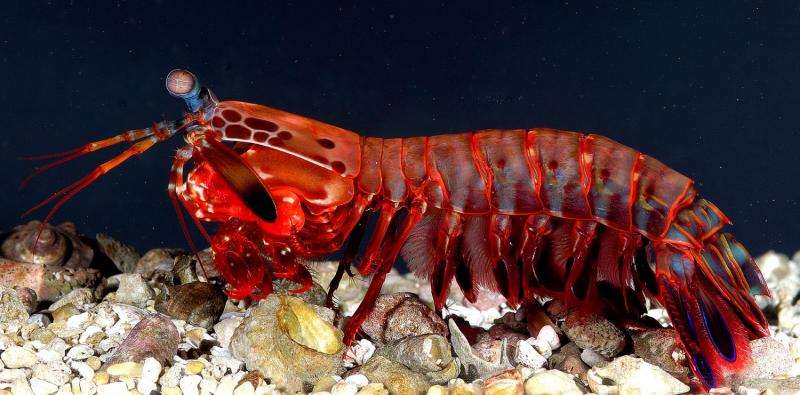September 23, 2015 report
Mantis shrimp found to spar safely with deadly weapons

(Phys.org)—A pair of biology researchers at Duke University has found that the mantis shrimp engages in an unusual form of sparring during territorial disputes—hammering each other on their tailplates. In their paper published in Royal Society Biology Letters, Patrick Green and Sheila Patek describe their initial expectations regarding behavior of the crustaceans and then what they actually observed.
Mantis shrimp, as it turns out, are not actually a type of shrimp—they are a close relative, a stomatopod. They are interesting because they have what amounts to a hammer, a raptorial appendage that can be pushed with tremendous and deadly force—enough to kill prey. In this new effort, the researchers report discovering that the tiny lobster-looking creatures also use their battering ram in another way, as part of resolving territorial disputes. They hammer each other on their backsides (telson) which are protected and thus little harm comes about.
Because disputes between members of the same species can often result in injury and/or death, many have evolved to using visual displays before resorting to a physical confrontation—the mantis shrimp, for example, engages in what is known as a 'meral spread' an apparent attempt to make itself look larger. Going in, the researchers believed that such displays likely meant relatively few physical encounters. They also expected that such displays would be a reliable means of demonstrating an individual's strike force, and that ultimately, when it came to blows, strike force would ultimately win out.
Instead, the researchers discovered after observing and testing several specimens, that the meral spread rarely prevented an escalation to violence—out of 34 encounters, just one dissipated. Also, they found that the size of the meral spread did not correlate to strike force and strike force was not a good predictor of success in a physical battle. The winner, they found, as in amateur boxing, was the one that struck the most blows. The loser tended to slink away in defeat. The researchers suggest such battles are a way for two rivals wanting the same burrow to communicate traits they posses such as persistence, endurance or grit—all without causing harm to the other.
More information: Contests with deadly weapons: telson sparring in mantis shrimp (Stomatopoda) Published 23 September 2015.DOI: 10.1098/rsbl.2015.0558
Abstract
Mantis shrimp strike with extreme impact forces that are deadly to prey. They also strike conspecifics during territorial contests, yet theoretical and empirical findings in aggressive behaviour research suggest competitors should resolve conflicts using signals before escalating to dangerous combat. We tested how Neogonodactylus bredini uses two ritualized behaviours to resolve size-matched contests: meral spread visual displays and telson (tailplate) strikes. We predicted that (i) most contests would be resolved by meral spreads, (ii) meral spreads would reliably signal strike force and (iii) strike force would predict contest success. The results were unexpected for each prediction. Contests were not resolved by meral spreads, instead escalating to striking in 33 of 34 experiments. The size of meral spread components did not strongly correlate with strike force. Strike force did not predict contest success; instead, winners delivered more strikes. Size-matched N. bredini avoid deadly combat not by visual displays, but by ritualistically and repeatedly striking each other's telsons until the loser retreats. We term this behaviour 'telson sparring', analogous to sparring in other weapon systems. We present an alternative framework for mantis shrimp contests in which the fight itself is the signal, serving as a non-lethal indicator of aggressive persistence or endurance.
© 2015 Phys.org




















